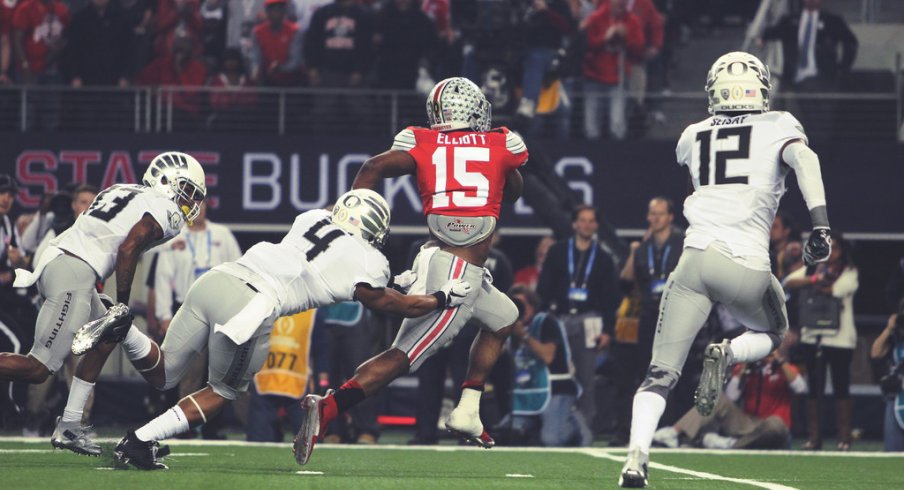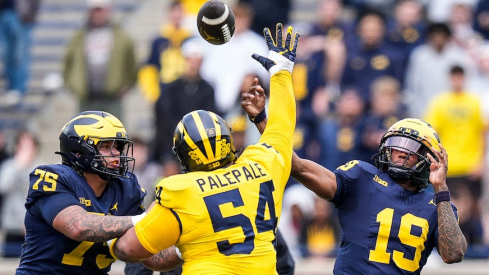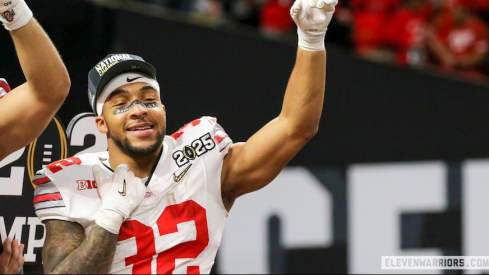Since the final whistle of OSU's ugly 20-13 victory over Northern Illinois last weekend, speculation has yet to cease about why the Buckeye offense failed to get off the ground against a mid-major opponent. Specifically, attention has centered around the inconsistent ability of the offensive line to open holes in the running game against a three-man defensive front.
However, those that have studied the Buckeyes and their opponents closely seem even more perplexed, as this is not the first time that this group has seen such a look from an opposing defense. Although the Huskies may have surprised them with the alignment, the 'Slobs' of the OSU offensive line tore through the Oregon Ducks' 3-4 defense in the CFP championship game just a short nine months ago.
While they were able to make a handful of adjustments in the second half against NIU that allowed Ezekiel Elliott to finally break off chunks of yardage, the Buckeye running game still failed to resemble the one we saw during their championship run. For OSU's entire offensive philosophy to get off the ground, it must first establish the run in order to open up the downfield passing game, something Urban Meyer has noted repeatedly in the past few days since when speaking to the media.
But for those wondering what exactly the Buckeyes can do if Western Michigan, Indiana, or any other opponent on their schedule lines up with an odd front, we can look back at that matchup with the Ducks for answers. OSU unveiled a number of wrinkles that night that led to 296 yards on the ground, and opened up an offense that put up 42 points on the scoreboard.
For those unfamiliar, an 'Odd' front is any defensive alignment that places a down linemen directly over the center and leaving the guards uncovered, often leading to either a three or five-man line (hence the name). However, it's entirely possible for an 'Even' front team, such as one running with basic 4-3 personnel, to line up this way too.
The issue for offenses is that most running concepts rely on the center being uncovered and allowed to either help with double-team or get upfield and block a linebacker. That nose-tackle directly over the center is often the man gumming things up for the entire offense if they're not ready for him, even if he's not the one making tackles. He'll often provide immense value simply by occupying multiple blockers and keeping the linebackers free to make tackles.
Against the Ducks, the Buckeyes attacked this look in two major ways that we have yet to see from them this year. The first was a simple adjustment to the 'split zone' look that has been a huge part of the OSU playbook since Meyer arrived four years ago.
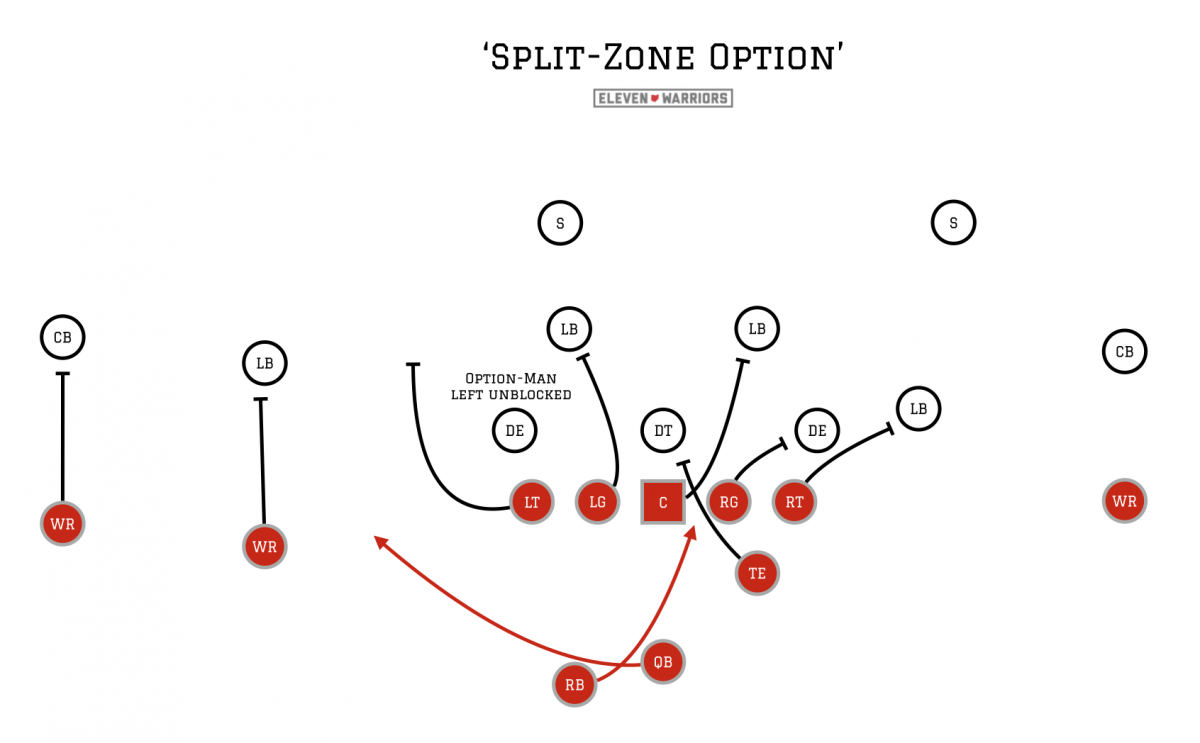
Instead of bringing the tight all the way across the formation to kick out the end man on the line and create a cutback lane for the running back, he instead sets what is really a trap block on the nose tackle. Given his angle from the side, the Tight End still has the necessary leverage to take on a man that outweighs him by 50 lbs or more, creating an inside running lane.

With the Nose now taken out of the play, the center and left guard are able to get upfield and engage with the linebackers immediately, allowing Elliott to get to the second level easily. Additionally, the Buckeyes slowed down the Oregon defensive line by using the quarterback to hold the weak-side defensive end with an option read.

Left tackle Taylor Decker doesn't even block the end in front of him, allowing the threat of Cardale Jones keeping the ball to act as a blocker in an of itself. His hesitation is enough to let Elliott slip past the line, while Decker is busy looking for defenders to block upfield.
But this wasn't the only concept that worked against the Ducks and could pay dividends if properly employed moving forward. The counter-trey has long been a featured part of Meyer's playbooks, gaining notoriety for the way it sprung Percy Harvin for countless big runs while at the University of Florida.
In Columbus, Meyer adapted the play for Braxton Miller to act as the ball carrier while at the quarterback spot, and was the play called when he hit his now-infamous spin move against Virginia Tech in week one. But since then, defenses have focused on stopping the run any time Miller takes the snap, hoping to avoid seeing themselves on SportsCenter over and over.
Against the Ducks, Elliott was the one dancing into the end zone thanks to the counter-trey. But although he ran found pay dirt four times that night, we've yet to see him take the handoff on the concept since.
The concept is a simple misdirection play, and is a classic 'gap' blocking concept. This means each lineman is responsible for blocking a specific gap regardless of who lines up there, unlike the fluid rules that are determined on the fly with zone blocking.
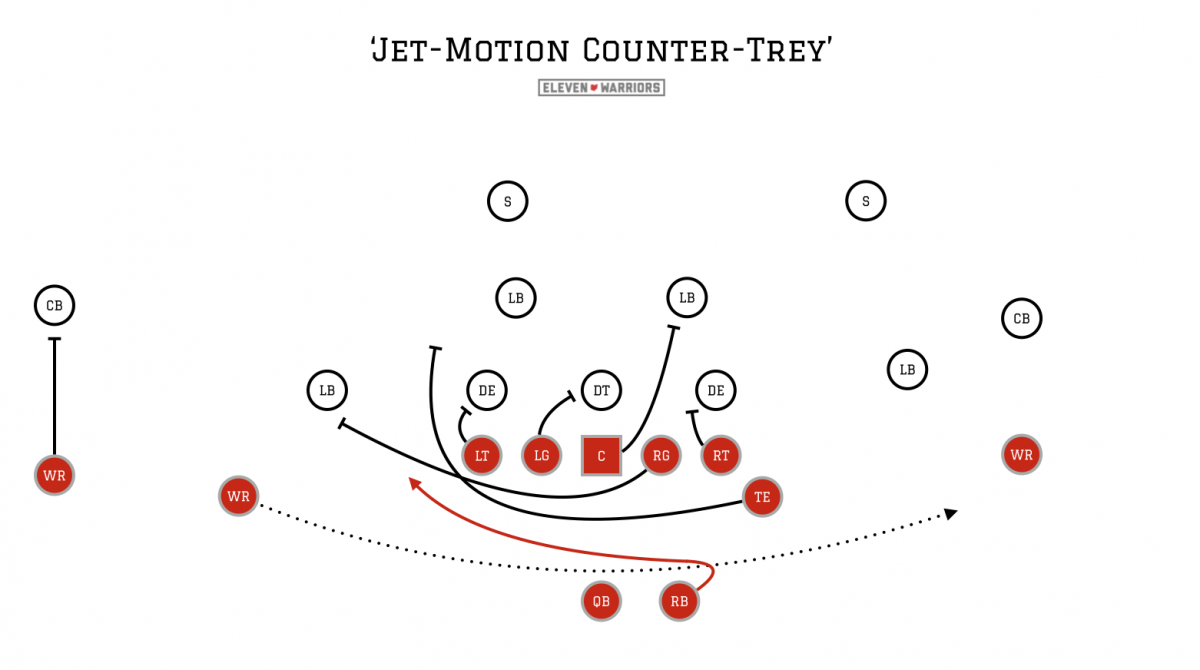
For a team like the Buckeyes that regularly calls for zone blocks, the initial first step of the offensive line in one direction signals the ball is going that way. Against the Ducks, OSU even brought a man in 'jet' motion to further sell the fake.
But after taking a jab step to sell the misdirection, the back takes the handoff going to the weak side, following a pulling guard and tight end who will kick out any defenders on the edge. The remaining blockers use their angled leverage (like the wham block above) to create a wall between themselves and the back, setting up a natural running lane.

Even though the inside linebacker reads the play correctly, he's still met at the line by the tight end, allowing Elliott to run untouched for 25 yards. With the most difficult blocks on the field receiving the advantage of added leverage thanks to these 'gap' schemes, the remaining blocks are made much easier.
While we might not know for sure whether Western Michigan will line up with an odd front or not until they hit the field this Saturday in Ohio Stadium, there's no reason for the Buckeyes to seem unprepared. While Meyer has said they'll be ready no matter what alignment comes their way, we can probably expect that they'll see an odd front again just to see if the offense is up to the task. They certainly have been before.
